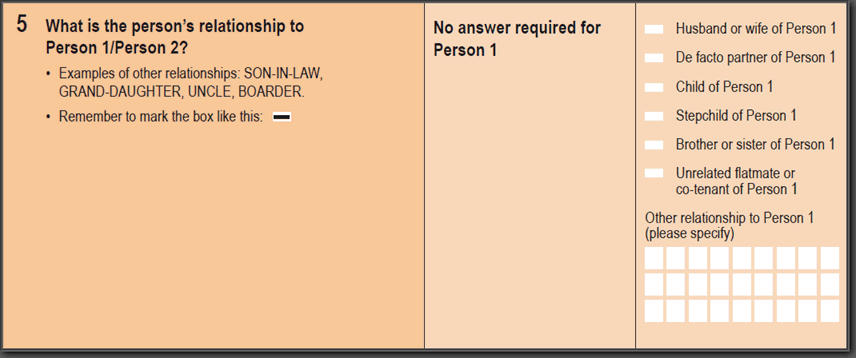Household Composition (HHCD)
Household Composition describes the type of household within a dwelling. It also indicates whether or not a family is present on Census night and whether or not other unrelated household members are present.This variable is applicable to all occupied private dwellings enumerated in the 2016 Census.
How this variable is created
In the 2016 Census, data on the household composition of private dwellings is mainly derived from the Relationship in Household question on the Census Household Form, which asks about each person's relationship to 'Person 1' on the form. An image of this question is provided below.
During the processing of Census data, families and household types are identified and created based around a 'family or household reference person', and Household Composition is derived for each dwelling. In cases where some members of a household, members of the main family structure (parents or children) or unrelated persons, are temporarily absent on Census night they are taken into consideration when deriving Household Composition. This allows for the identification of some family types, and also for distinguishing between lone person and group households.
The 'Other not classifiable' category consists mainly of occupied dwellings where a form was not received, this represents 4.8% of all occupied private dwellings.
Variable history
The specific Household Composition classification was first used in the 2006 Census. Between 1986 and 2001 some information had been collected through the variable Household Type. Other information on families was also collected prior to 1986, though the older variables did not contain as much detail as what is now collected. No changes were made in 2016.
Non-response rate
Non-response rate only applies to data items that directly reflect responses to individual Census form questions. Household Composition does not have a non-response rate as it is a derived value created during Census processing for applicable households. For more information, refer to Understanding Census data quality.
Data usage notes
For many households, identifying relationships to assist the coding of family or household structures for a dwelling is quite straightforward. However, across the community, a wide variety of living arrangements exists and family structures can be complex and dynamic in nature. The quality of family data in the Census is partly dependent on people’s ability to describe these relationships within the constraints of the generalised questionnaire format required by a Census. Reporting relationships in respect of 'Person 1' only, can make it difficult to establish all the relationships which exist in a household, or to identify whether more than one family is living in the dwelling.
Household Composition should be used carefully when comparing to other dwelling data from within the ABS and for external organisations or agencies. Relevant definitions can differ between different statistical collections and may not match Census definitions.
Further information
A definition of Household Composition is available in the 2016 Census Dictionary.
Household form question image
Question 5 as it appeared on the 2016 Census Household Form:

A text only version of the online Census Household form is available from the Downloads tab.
 Print Page
Print Page
 Print All
Print All